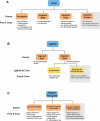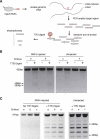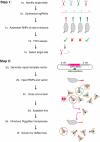A pipeline for precise and efficient genome editing by sgRNA-Cas9 RNPs in Drosophila
- PMID: 33016195
- PMCID: PMC7746241
- DOI: 10.1080/19336934.2020.1832416
A pipeline for precise and efficient genome editing by sgRNA-Cas9 RNPs in Drosophila
Abstract
Genome editing via homology-directed repair (HDR) has made possible precise and deliberate modifications to gene sequences. CRISPR/Cas9-mediated HDR is the simplest means to carry this out. However, technical challenges remain to improve efficiency and broaden applicability to any genetic background of Drosophila melanogaster as well as to other Drosophila species. To address these issues, we developed a two-stage marker-assisted strategy in which embryos are injected with RNPs and pre-screened using T7EI. Using sgRNA in complex with recombinant Cas9 protein, we assayed each sgRNA for genome-cutting efficiency. We then conducted HDR using sgRNAs that efficiently cut target genes and the application of a transformation marker that generates RNAi against eyes absent. This allows for screening based on eye morphology rather than colour. These new tools can be used to make a single change or a series of allelic substitutions in a region of interest, or to create additional genetic tools such as balancer chromosomes.
Keywords: CRISPR; Drosophila; gene editing; homology dependent repair.
Conflict of interest statement
The authors declare no competing financial interests.
Figures




Similar articles
-
CRISPR-/Cas9-Mediated Precise and Efficient Genome Editing in Drosophila.Methods Mol Biol. 2022;2540:135-156. doi: 10.1007/978-1-0716-2541-5_6. Methods Mol Biol. 2022. PMID: 35980576 Free PMC article.
-
Highly specific and efficient CRISPR/Cas9-catalyzed homology-directed repair in Drosophila.Genetics. 2014 Apr;196(4):961-71. doi: 10.1534/genetics.113.160713. Epub 2014 Jan 29. Genetics. 2014. PMID: 24478335 Free PMC article.
-
Highly efficient DNA-free gene disruption in the agricultural pest Ceratitis capitata by CRISPR-Cas9 ribonucleoprotein complexes.Sci Rep. 2017 Aug 30;7(1):10061. doi: 10.1038/s41598-017-10347-5. Sci Rep. 2017. PMID: 28855635 Free PMC article.
-
[CRISPR/CAS9, the King of Genome Editing Tools].Mol Biol (Mosk). 2017 Jul-Aug;51(4):582-594. doi: 10.7868/S0026898417040036. Mol Biol (Mosk). 2017. PMID: 28900076 Review. Russian.
-
Precision genome editing in the CRISPR era.Biochem Cell Biol. 2017 Apr;95(2):187-201. doi: 10.1139/bcb-2016-0137. Epub 2016 Sep 29. Biochem Cell Biol. 2017. PMID: 28177771 Review.
Cited by
-
Fourth Chromosome Resource Project: a comprehensive resource for genetic analysis in Drosophila that includes humanized stocks.Genetics. 2024 Feb 7;226(2):iyad201. doi: 10.1093/genetics/iyad201. Genetics. 2024. PMID: 37981656 Free PMC article.
-
Robust and heritable knockdown of gene expression using a self-cleaving ribozyme in Drosophila.Genetics. 2024 Aug 7;227(4):iyae067. doi: 10.1093/genetics/iyae067. Genetics. 2024. PMID: 38701221 Free PMC article.
-
State-of-the-art CRISPR for in vivo and cell-based studies in Drosophila.Trends Genet. 2022 May;38(5):437-453. doi: 10.1016/j.tig.2021.11.006. Epub 2021 Dec 18. Trends Genet. 2022. PMID: 34933779 Free PMC article. Review.
-
The underappreciated, underrecognized problem of fourth chromosome trisomy in Drosophila melanogaster stocks and a simple, general method for building diplo-4 stocks from triplo-4 stocks.MicroPubl Biol. 2025 Apr 29;2025:10.17912/micropub.biology.001606. doi: 10.17912/micropub.biology.001606. eCollection 2025. MicroPubl Biol. 2025. PMID: 40385372 Free PMC article.
-
CRISPR-/Cas9-Mediated Precise and Efficient Genome Editing in Drosophila.Methods Mol Biol. 2022;2540:135-156. doi: 10.1007/978-1-0716-2541-5_6. Methods Mol Biol. 2022. PMID: 35980576 Free PMC article.
References
-
- Klompe SE, Vo PLH, Halpin-Healy TS, et al. Transposon-encoded CRISPR-Cas systems direct RNA-guided DNA integration. Nature. 2019;571:219–225. - PubMed
Publication types
MeSH terms
Substances
Grants and funding
LinkOut - more resources
Full Text Sources
Other Literature Sources
Molecular Biology Databases
Research Materials
